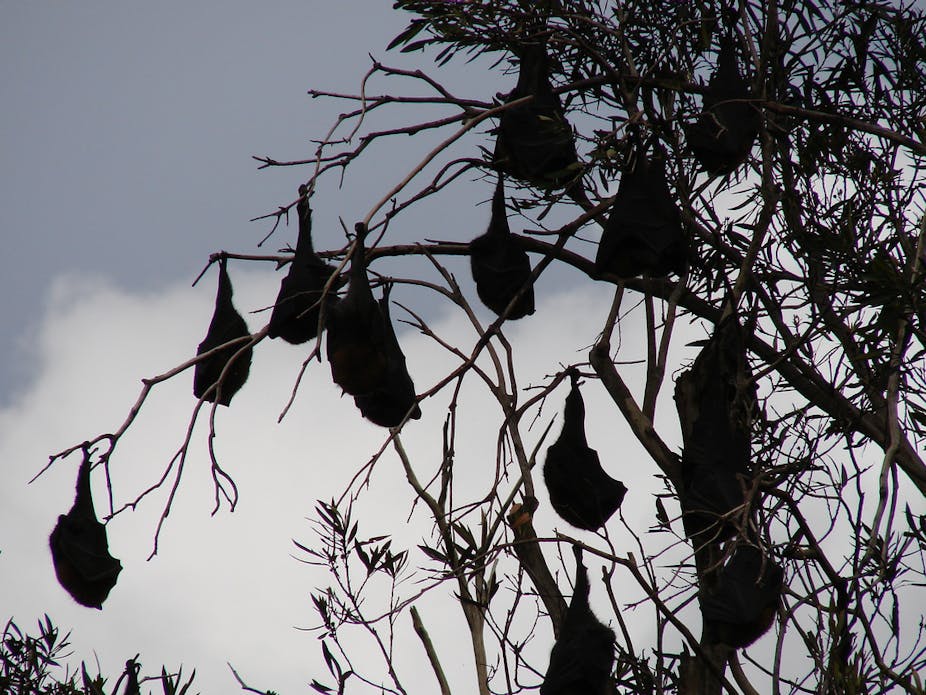The recent tragic death of a young boy from Australian bat lyssavirus (ABL) produced a predictable chorus of calls to disperse flying fox colonies and kill flying foxes, all in the name of public health. But does persecuting bats actually make us safer?
Protections for bats are being reduced. In Queensland, anyone who wants to disperse a colony has to obtain a Damage Mitigation Permit. Until recently, rules governing these permits covered all protected animals in Queensland. In the latest version of the regulations, flying foxes are given a separate sub-clause which exempts them from the humaneness test that applies to other animals. This is a significant step, making it much more likely permits for dispersing flying foxes will be granted.
The Queensland Premier has suggested he might go further, raising the possibility of employing state government “bat squads” to remove flying fox colonies from urban areas.
Why culling and dispersal don’t work
Dispersing and culling flying foxes cannot eliminate the risk posed by bat lyssavirus. All public health bodies state that there is no inherent public health risk posed by the presence of flying fox colonies. They recommend that members of the public do not touch bats and that they seek medical advice should they have direct contact with one. These two simple measures virtually eliminate the risk of infection with the virus.
Culling can prevent the transmission of a contact-spread virus such as Australian bat lyssavirus, but only if it reduces the density of a bat population to a level where infected animals die before they can pass the disease to another host. Given the low levels of ABL antibody prevalence in flying foxes, the level of culling required to break the transmission cycle within the bat population is phenomenal.
If flying foxes were static occupants of a defined territory, it might be possible to kill enough of them to achieve this goal. But flying foxes live peripatetic lives, moving from colony to colony over impressive distances. Bats killed in urban colonies are simply replaced by others, yielding no net long-term reduction in the size of urban colonies or the pool of animals potentially exposed to lyssavirus.
Attempts to disperse colonies generally fragment them. The fragments become smaller colonies in adjoining suburbs and private spaces, raising, rather than reducing the possible close contact between residents and flying foxes. Colonies re-form and re-occupy roosts, so dispersal is a process which needs to be repeated time and again.
Frank Beveridge, the Mayor of Charters Towers, has had much experience of brute force colony dispersal and concedes that it does not work. His council is now embarking on a far-sighted experiment intended to sustainably move flying foxes into a new publicly acceptable roost site.
Bats and forest biodiversity
Functioning communities of flying foxes provide economic benefits - do we really want to risk those by culling? Flying foxes are the major pollinators of many timber and honey trees. Loss of pollinators has measurable effects on the vitality of forests which provide tangible economic benefits to society.
Flying foxes perform their roles of pollinators and seed dispersers collectively, their effectiveness being tied strongly to presence of a critical mass of animals in the environment. Killing flying foxes at the scale required to influence the occurrence of lyssavirus would disrupt a critical link in forest biodiversity, health and productivity.
Forests do not collapse over night. They slip away, and will, if loss of flying foxes is added to the other challenges they face.
Beyond health risks
Australian bat lyssavirus has now claimed three human lives. It would trivialise the effect of those deaths to get into arguments about the virus in comparison to other causes of death. But it is important to note that, as measured by antibody occurrence in bats and the experience of bat carers, this is a rare virus and the use of heavy-handed reactive methods to solve a complex problem is poor policy.
If culling and dispersing bat colonies cannot be justified on public health grounds, it is hard to avoid the conclusion that the hysterical reaction to having flying fox colonies in urban areas comes more from residents who dislike the noise, smell and occasional damage to vegetation caused by large flying fox camps.
Our political leaders need to do more than just parrot the concerns of their most vocal constituents. The interconnectedness of human health, wildlife and the environment is being increasingly recognised. Simplistic or populist approaches to human-wildlife conflicts can lead to far reaching consequences for no overall benefit.


